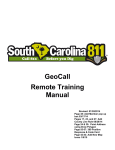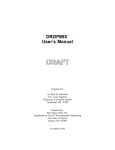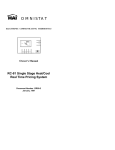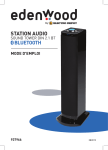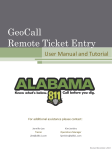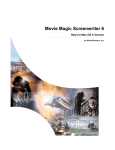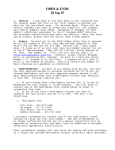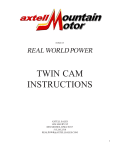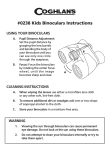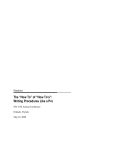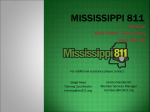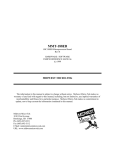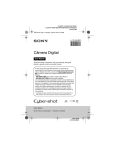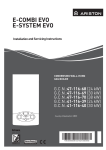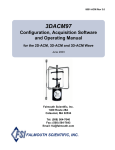Download Remote User Manual
Transcript
GeoCall Remote Training Manual TABLE OF CONTENTS SC811 Remote User Information Remote Access Welcome Screen Notice View & Tool Bar Filling out the Locate Notice Caller/Company/Site Contacts Done By/Duration/Drill/Bore/Explosives/RR Custom Field (Subd/Done For) Work Site Location Notice Type Field Notice Types: • Normal • Design • Subaqueous & Actions Work Type and Work Date & Time Field State/County/Place Fields Address & Intersection Fields Directions & Instructions Fields SC811 Location Entry Guidelines Other Locate Notice Examples & Guidelines • Single/Multiple Addresses • Point Address • No Specific Address • Apartment/Mobile Home Parks • Unknown Roads/Alleys/RR • Unknown Easement/Right of Ways • Lat & Long • Intersection Notices • County Lines • Working along a Road • Footage Segments Remarks Field & Example of completed notice Mapping Tool Bar Map Legend Locating the Dig Site Map Search Tool Mapping the Dig Site & Site markers • Draw Point • Draw Line • Draw Polygon Members Section Adding Members Disclaimers/Notice Number Update & Expiration Dates 2 3 4 5-6 Replicate & Secondary Action 45 Cancel 46 No Show 47 Resend 48 Remark 49 Update (on time) & Late 50 360 Positive Response & Codes 51-54 Notice & Action Overview 55 7-8 9 10 10 11 12 13 14 14 15-16 16 17-20 21-30 21-23 21 23 24 24 25 26 27 28 29 30 31 32-33 33-34 35-36 37 38 38 39 40 41 42 43 44 1 SC811 REMOTE USER INFORMATION The Remote User program is for companies/excavators who need notices on a regular basis and wish to have the capability to enter certain types of notices online 24 hours a day/7 days a week. Notices entered via the Remote User application will be processed through the system and will be sent to the member operators, just as if the excavator phoned in the request. Remote notice entry allows users to process Normal, Design, Subaqueous, Update, No Show, Remark, Resend, and Cancel notices from their own computer. Once the notice is entered, the Remote User maps the site location and receives a notice number automatically. After the notice has been processed, the locate notice will have a Work date and time which is how long the members have to respond, an expiration and update date and a list of member operators SC811 will be notifying. Positive Response became active June 7th, 2015. You are responsible for checking Positive Response prior to excavation and closing out your locate notices once all excavation has been completed. When using Remote entry, be sure to verify all of the information on the notice to ensure the accuracy for the protection of your company and the member operator’s underground facilities. After you have saved your request, it is processed automatically. The systems’ accuracy depends on you. If you find any discrepancies in your submission, it is your responsibility to correct the notice(s) yourself or notify SC811 center directly for assistance. By using Remote entry, you agree to be legally responsible for the accuracy of the information provided about the proposed work site. In South Carolina, the state law requires a 3 full working days notice excluding the day the notice is entered, weekends and holidays for the member operators to respond (this excludes Subaqueous and Design Notices). Please keep in mind that although the system is online 24 hours a day 7 days a week, any notices entered during the weekend, any holidays, or after 11:59 pm will be sent through the next business day at 7:30 am. (The list of holidays is provided on the “Welcome Screen” No Show notices cannot be processed during SC811 “After-Hours which is any time between 5:30 pm and 7:30 am, any holiday that is observed by SC811, and weekends. If an Emergency locate notice is needed, it must be called directly in to the SC811 notification center at 1-888-7217877 or 811. These are taken 24 hours a day and seven days a week. Your locate notices are very important. These guidelines and procedures are necessary to expedite your locate notices and to enhance public safety. By using the Remote application, you are pledging to follow these published requirements. Your user name and password are essential security items to protect the Remote User. Sharing your username and password may result in your Remote privileges to be Suspended MONITORING THE SYSTEM: To ensure that each remote user is complying with SC811 Entry Guidelines locate notices may be reviewed. Areas of concern or locate notice(s) with errors will be addressed in an email and/or you may be contacted directly by phone. Locate notices may be reviewed to ensure that each remote user is complying with SC811 Entry Guidelines, entering locate notices properly and providing accurate damage prevention information. Areas of concern or locate notice(s) with errors will be addressed via an email and/or a direct phone call. SC811 is here to assist each remote user with any areas of concern however, if there is a situation where after several attempts have been made to help correct errors and no improvement has been shown, your account may be suspended or terminated. We have a help desk available for any questions from 7:30 am until 5:30 pm, Monday through Friday. Please call 800-290-2783 (option 5) or email [email protected]. **You may only enter locate notices for the company you are working with at the time of the training. If there is a change in the company you work for you must contact SC811 to be able to enter for the new company** 2 How to access Geocall: (you must be approved by SC811 before you can access our system) Go to www.sc811.com Click on “Apps” at the top of the page Select “Remote User “ Click on the “Geocall Login” icon which will take you directly to the Log In Screen Log in screen is where you will enter your User Name and Password (which is assigned by SC811) After you enter your credentials, click the Log in button to get started 3 WELCOME SCREEN The welcome screen will show various information ranging from mapping tool reminders to upcoming holidays. 4 GEOCALL MAIN TASK BAR & METHODS OF PULLING EXISTING NOTICES Selecting this Icon will open a new locate notice. When selecting “new” you should be processing the following notices: Normal, Design and Subaqueous. SC 811 TOOL BAR FUNCTIONS Click Notification: 3 options will appear Notice Number: This is used when an existing notice needs to be pulled for viewing or to perform a secondary action. Once you click on Notice Number, a box will pop up and you will enter the locate notice number. Then click “ok” and the notice will pull up for you to view. Remote Notice Search: allows you to search for a locate notice that was originally entered under your user name only. You can only search one day at a time and by these selected criteria ranges: When using this feature, keep in mind “less is best” when searching. For Example if you searching for a notice that had the address of “810 Dutch Square Blvd”. In the Street Field just provide “Dutch”, street endings are not included. Information in the other fields may be entered, select the date. The system will filter on The Notice entry screen is broken down into three sections, Company/Caller Work Site the datethe selected all notices Information, that you entered that Information and the Mapping Information. There arecontain two ways to move around thename. Notice screen, you can “Dutch” in the street TAB through each field or use the mouse arrow to selected fields. All information will need to be entered in all caps (except email addresses). 5 My Notices: shows you a view your notices entered for the day to the right of the Task bar. Response: This is used when the digging has been completed and you are ready to “close out” the locate notice. For more information on Positive Response refer to the Positive Response section. Locate Notice Form **Red fields are required** The Notice entry screen is broken down into sections, the Company/Caller Information, Caller, Site Contact, Custom and Work Location. There are two ways to move around the Notice screen, you can TAB through each field or use the mouse arrow to selected fields. **ALL LOCATE NOTICE INFORMATION MUST BE ENTERED IN ALL CAPS** The next several pages is a step by step demonstration when filling out each field on the locate notice request. Each notice type and the actions that can be performed will be demonstrated in this manual for accurate and user friendly step-by-step processing. 6 Caller Information-This section is for your company information which is requesting the Notice. Company Name/Address/City/State/Zip: This information needs to be the name of the company and address information that you were trained to enter locates notices for. Fax: This field is for the company fax number if available. (not required) Type: This field is used to best describe the company in the Company Name field. • Contractor- A person or company that undertakes a contract to provide materials or labor to perform a service or do a job. • Excavator- Any person engaged in excavation or demolition. • Facility Operator- a company that subscribes notifications to SC811 to protect their underground facilities. • Other- any other type that does not apply with selection provided. Source: Indicates how the notice was processed. Your Notice source is Remote. If you are following up on an existing locate notice what was not originally processed via Remote you will need to change the source to Remote before you can save the locate notice. Copy To: Will automatically send email copy if an email address is provided in the email field. Phone: This field is for your daytime phone number where you can be reached during the day. When entering the phone number, do not include dashes or parenthesis. This number will auto populate the entire section. Suppression Numbers: This is used when your company is part of the suppression program. These numbers will start with (000) 000- (The last 4 digits will change). When there is a (000) 000-0000 in the Phone field, you must make sure there is a valid number in the Caller field. You may have to manually enter a valid telephone number in this field. This telephone number is for the locators to be able to reach the contractor if they need too. After mapping a location, that member operator will be suppressed and will not get a copy of the locate request. Do not alter this in any way. The Suppression telephone determines which Member Utility will be suppressed. 7 Ext field Caller: This field needs to reflect your name when entering new locate notices. First and last name is required. If you are copying an old locate notice, make sure you change this field to your name if someone else called in the locate notice. Phone: This field is the second phone field located under the Caller information field. This will auto populate your daytime number. This field can be modified if needed. The small box behind it is for an extension number, Email: This field is for your email address or whomever you would like to receive the notice. Only one email address can be provided in this field. It is against SC811 policies to Resend or Update a Notice to add this information. If you forget to check the Email Copy box: You can print your locate notices by going to the “Action” icon and then select Print or contact 1-800-290-2783 option 1 Site Contact: Name of the person the member operator(s)/locator(s) should contact if they have any questions. Ext field is available Name: This field is for the person’s name. Alternate contacts need to be provided in the Instructions field. Phone: This field is for the site contact’s phone number. Email: This field is for the site contact’s email address. Note this is NOT where the email copy will be sent. Callback: This field is only for additional information about the site contact. For example they may have additional information such as best time to reach the site contact in this field. 8 Done By: This field is for the name of the company who will be doing the excavation/digging work that is specified in the Work field on the notice. It is important that this information is entered correctly, especially if the digging work will be done by someone other than your company. Otherwise, the information in the Company field will automatically populate in the Done By field when the TAB key is pressed. The company in this field is covered on the notice for the type of excavation/digging work that is given in the Work field. Multiple Contractors: If your company wants to cover several different subcontractors/companies on the notice, you will need to put “See Instructions” in the Done by field and make note in the Instructions field the companies you are wanting to cover for digging. If there is going to be several types of digging work with multiple contactors doing work, you will need to provide every type of digging work that is taking place and which company will be performing the work. These subcontractors can perform secondary actions on your locate notices. Duration: This field is for the approximate time frame for the job. If you are not sure you may put “Unknown” in this field. Example: About 1 day, or Approx 2 hours Explosives, Premark, Boring/Drilling, RR: These boxes will need to be checked if any apply to work taking place on the locate notice. If you are not sure, check the box and make notation in the Directions field: “UNSURE IF ANY____ TAKING PLACE”. Explosives: using dynamite/any type of explosives on the job site Premark: if the work area has been staked , painted or flagged to indicate where the work is taking place (a description of where the area is premarked and/or marking instructions is required information – note this in the Instructions field) Drilling/Boring: if using any type of machine to perform any of the digging work Near Railroad: if the work site is within ¼ mile or eyesight of a railroad track (alerts Fiber companies) 9 Subdivision: This field is for the subdivision name, if provided. If the site is in a section of a larger subdivision you may enter both. For example: Ashley Ridge at Belle Hall Plantation. Done For: This field is for the name of the company or person that the work is being done for. Addresses In Instructions: This box will need to be checked when multiple addresses are provided on the notice. SC811 Use Only: First time Caller? ; Learn of SC811? ; Additional Info; Damage/Emerg and If Yes How? Work Location Information - This section is for the actual work site information such as: The type of work taking place, Notice type being processed, marking instructions, special notations for locators and/or directions. The most important this to remember when entering information on the locate notices is that this is a legal document. Make sure that all information is entered accurately and mapped according to the information provided regarding the work site. Mapping the location incorrectly can affect member operators who need to be notified. This could result in someone getting hurt and unnecessary cuts to underground utility lines. Notice Type: This field is used to indicate the type of notice that needs to be processed. This field will automatically populate as Normal when has been selected. To change the Notice Type, use the drop down menu and select the Notice Type that is needed. In the drop down, you may see some notice types which will not be explained in this manual, that is due to Remote Users do not have rights to process those types of notices. **It is very important to use the drop down to select the notice type when changing the notice type. This will ensure that the correct work date and time will reflect in the fields which comply with the notice type being selected. Emergency notices cannot be entered by Remote Users; they have to call directly into the call center at 1-888-721-7877 or 811. 10 NORMAL This is the most commonly used locate notice when any type of digging work is taking place. It also used when digging is to be done on Survey tickets and if the locators need to meet on site; notations will need to be made in the Instructions field. The South Carolina state law requires a 3 full working days notice excluding the day the notice is entered, weekends and any holidays to respond. It may be scheduled up to 12 full working days in advance. Be sure to make note in the Instructions section of the change of the 3 full working days notice and when the digging work is scheduled to begin. Making notation requesting the area to be marked asap or before the 3 full working days notice is against SC811 guidelines.This notice type can be entered 24 hours a day 7 days a week. Never Suppress members on this locate. To adjust the work date and time, click on the calendar icon. Select the work date that you would like to have the area marked. The date range that can be selected will available. The system will not let you schedule over 12 working days in advance. The other type of notice that can be scheduled in advance will be a Subaqueous notice which is 20 full working days in advance. Never set locates up on weekends or holidays! To create a Normal notice: 1. Click New Icon 2. Verify Notice Type is Normal. 3. Fill out all fields and provide detailed marking instructions. You will always need to include the following information: • Directions Field– used for additional roads, alternate street names, directions to work site and landmarks • Instructions Field– marking instructions, special notations for locations and any other information pertaining to the locate request. You also make notation of who the locators need to contact if a Meet is required. • Plot the area of the work site location on the map. 4. Verify all information on the locate notice before Saving 5. If processing a single locate notice you may click on the icon. The locate notice number will generate. You cannot go in on an existing notice and change information once the notice has been saved. If multiple notices need to be made: • Click the Save icon (this is located directly to the right of the Save and Close icon). This will generate the notice number and then allow the notice to be Replicated to create a new notice saving the information from the previous notice. • Click Replicate icon • Click Remove Work Information icon . This function will remove the County, Place, Address, the Street, the Intersecting Street, and the mapping of the previous locate. (This step is optional.) Complete the notice using the above instructions. • . Example of notes when a meet is required 11 DESIGN This type of notice is a non-excavation notice and does not cover any digging work. With a Design notice, The South Carolina state law requires a 15 full working days notice excluding the day the notice is entered, weekends and holidays to respond. A normal locate notice must be called in before any digging work takes place. Follow ups can be made on this locate notice. This notice type can be entered 24 hours a day 7 days a week. Never Suppress members on this locate. To create a Design locate notice: 1. Click New Icon 2. Verify Notice Type is Design. 3. Fill out all fields and provide detailed marking instructions. You will always need to include the following information: • Directions – used for additional roads, alternate street names, directions to work site and landmarks • Instructions – marking instructions, special notations for locations and any other information pertaining to the locate request 4. Plot the area of the work site location on the map. 5. Verify all information on the locate notice before Saving 6. If processing a single locate notice you may click on the icon. The locate notice number will generate. You cannot go in on an existing notice and change information once the notice has been saved. If multiple notices need to be made: • Click the Save icon (this is located directly to the right of the Save and Close icon). This will generate the notice number and then allow the notice to be Replicated to create a new notice. • Click Replicate icon • Click Remove Work Information icon . This function will remove the County, Place, Address, the Street, the Intersecting Street, and the mapping of the previous locate. (This step is optional.) Complete the notice using the above instructions. An example of the Work Location Information section on a Design locate notice: • . F9 EXPANSION “Members will be notified to contact the caller within 15 full working days to make arrangements for the Design locate notice”. 12 SUBAQUEOUS This type of notice is where the work will take place under a body of water, including rivers, streams, lakes, waterways, swamps and bogs. The South Carolina state law requires a 10 full working days notice excluding the day the notice is entered, weekends and holidays to respond and may be scheduled up to 20 full working days in advance. Be sure to make note in the Instructions section of the change of the 10 full working days notice and when the digging work is scheduled to begin. On Subaqueous Notices the Tolerance Zone is 15ft out either side of an indicated facility. Making notation of requesting the area to be marked asap or before the 10 full working days notice is against SC811 guidelines. Never Suppress members on this locate. To create a Subaqueous locate notice: 1. Click New Icon 2. Verify Notice Type is Subaqueous. 3. Fill out all fields and provide detailed marking instructions. You will always need to include the following information: • Directions – used for additional roads, alternate street names, directions to work site and landmarks • Instructions – marking instructions, special notations for locations and any other information pertaining to the locate request 4. Plot the area of the work site location on the map. 5. Verify all information on the locate notice before Saving 6. If processing a single locate notice you may click on the icon. The locate notice number will generate. You cannot go in on an existing notice and change information once the notice has been saved. If multiple notices need to be made: • Click the Save icon (this is located directly to the right of the Save and Close icon). This will generate the notice number and then allow the notice to be Replicated to create a new notice. • Click Replicate icon • Click Remove Work Information icon . This function will remove the County, Place, Address, the Street, the Intersecting Street, and the mapping of the previous locate. (This step is optional.) Complete the notice using the above instructions. • . Subaq- Cancel: Used if pertinent information on the original notice needs to be changed. Cancellations can be done at anytime on the locate notice. This goes to all member operators – never suppress. Subq- No Show- Used when an area is not marked by all/certain member operators and the 10 full working days has expired. You must check Positive Response before performing this action. Member operators have 3 hours to respond. You must suppress members that have positively responded. Subq-Remark: Used when the area needs remarked due to markings are no longer visible by weather, fading or someone destroyed the marks. This will issue new good through and update dates. This goes to all members – never suppress. Subq-Resend- Used to add a notation or comment to an existing notice that does not change any of the original information or if there are signs of underground facilities with no marks and Pr is in the system. If the 10 full working days has not expired, please make sure to change the date and time. Suppress all members if you are resending to add a member operator. Subq-Update- when a notices needs to be extended for more digging time. It goes to all member operators. 13 Work Type: This field is where you select the type of work that is taking place on the job site **Note your company is only covered for the digging work specified on the locate notice** The drop down list is in alphabetical order. When there are several types of work taking place on the locate notice you are processing or the type of work taking place is not listed to select, you need to go to the Instructions section and provide every type(s) of digging work that will be taking place. See page 9 for an example of multiple contractors doing different types of work. Below is an example of selecting “See Instructions” Work Date & Time: : This field will reflect the work date and time the members have to respond to the notice. It excludes the day the notice is entered, weekends and holidays. These fields cannot be adjusted to set a date/time prior to the 3 full working days notice. Making notation of requesting the area to be marked asap or before the 3 full working days notice is against SC811 guidelines. State: This field is defaulted to SC since SC811 only processes locate notices for South Carolina. County: : This field is for the County the work is taking place in. You may type in the first couple letters of the county name or use the drop down list for a selection to choose from. When a location is in two counties or if the site marker buffer of any of the draw tools (Point, Line, or Polygon) crosses a county line, you will need to process a notice for each county. Place: This field is for the closest city/town the work is taking place in. Type in the first couple of letters of the city/town name or use the drop down list for a selection to choose from. If you do not see the city/town that the work is taking place in as an option to select, you will need to manually type it in. See below: Charleston County, Johns Island Notice in the drop down selection that “Johns Island” and not an option to select. This does not mean that the SC811 map will not find the location nor does it mean that you cannot provide Johns Island as your information. You will need to type the information in manually. Tip: When the system tries to locate the dig site on the map, it is zoned in on the County and Address provided. 14 1st 2nd 3rd 4th 5th When typing in these fields, do not put spaces in front or behind the information. Doing so can affect the mapping process. Address Field (1st box): This field is for a single address only. If the work is taking place at more than one address you will leave this field blank and make note of the addresses in the Instructions field. SC811 can process up to 5 addresses, lots, buildings that are directly side by side on each. When working at multiple addresses make sure the “Addr in Instr” box is checked. Instructions field Prefix & Suffix Field (2nd & 5th box): This field is for directional information only, such as North- N, East- E, South- S, West- W, Southwest- SW, Northwest- NW, Southeast- SE, Northeast- NE, which relates to the street name. Example: N Main St or Main St N. **Please do not use these when providing marking instructions or directions to a work site** Street Field (3rd box): This field is for the road the work is actually taking place on or the site is located on. This is the road that is covered for digging. Street endings (i.e. Dr. St.) do not go in this field. If it has an alternate name or highway number, you will need to make notation in the Directions field (Note: If the street provided is S 5th St Ext, you will enter S in the Prefix field and 5th St Ext in the Street field. Street: Entering Highways- When entering highways in the street field, you will not include, “State”, “US” or “SC”. The abbreviation for Highway will be entered in the Street field in this case. For example: Caller gives: SC Hwy 1Enter: Hwy 1 in the Street field. In some cases, SC 811 map may not acknowledge the highway number. In this case, ask the caller if the highway also has an actual highway name. If the highway does have a name, you will make notation in the Instructions field. Highway: Entering Interstates- When entering interstates you simply enter I (space) then the number in the Street field (I 26). You will not have to spell out Interstate. Interstate: Entering Unknown- If the work is taking place along a cross country right of way, railroad tracks, interstate ramps, streets that are not named , and unknown alleys , “UNKNOWN” goes in the street field and in the Directions section you will need to specify what the unknown is representing and where it is located. Unknown: Entering Secondary Roads- When entering these types of roads, in the Street field you will enter S-1-11. The first number will be the county number and the second number is the actual road number. In these cases, SC 811 may not acknowledge these types of roads. In this case, ask the caller if this road has an actual road name. If the road does have a name, you will make notation in the Instructions field. 15 Type (4th box): This field is for the street ending to the road name, such as Dr, Rd, Cir, etc. SC811 map works better when providing the acceptable abbreviations. ACCEPTABLE ABBREVIATIONS Avenue- AVE Boulevard- BLVD Bypass- BYP Circle- CIR Crossing- XING Drive- DR Expressway- EXPY Highway- HWY Lane- LN Parkway- PKWY Place- PL Point- PT Road- RD Street- ST Square- SQ Terrace- TERR Trail- TRL Trace- TRC Intersection Field: This field is for the nearest intersecting street to the job site and needs to actually cross or touch the road the work is taking place on. If the intersecting street has a highway number and street name, enter only one road name in the Intersection field and provide the alternate road name in the Directions section. For example: “Sunset Boulevard is also known as Highway 378”. This green arrow will start the mapping process. Directions Field: This field will be directions to the work site, additional cross streets, any landmarks in area, alternate street names or if SC811 map shows streets/places differently than what is provided. If the location where the digging work is taking place is new and/or is not located on SC811 map, directions to the site must be provided. Marking instructions do not go in this field. If you do not have or need to supply additional information in this field you may put “N/A” or “NONE”. MISCELLANEOUS ABBREVIATIONS THAT CAN BE USED ON THE NOTICE Air Force Base- AFB Building- BLDG Subdivision- SUBD Also Known As- AKA Condominiums- CONDOS Apartment- APT Directions- DIRS Approximately- APPROX Feet or Foot- FT As soon as possible- ASAP Intersection- INTERS Instructions Field: This field will inform what part of the property needs to be marked, special marking instructions, and any additional information pertaining to the notice being processed. Marking instructions are required on all locate notices and need to be very clear for the locators. The locators/member operators are only obligated to mark requested locations within SC811 guidelines. When providing marking instructions and directions, always ask yourself, “Would I be able to find and mark this site using only the information provided? The next couple of pages will go over location entry guidelines and how to enter certain locate notices. 16 SC811 LOCATION ENTRY GUIDELINES 1. NO MORE THAN 1320 FEET CAN BE MARKED PER LOCATE NOTICE • This rule only applies when markings need to be done along a road, easement, right-of-way, sidewalk, or alleyway • This rule does not apply when markings need to be done on a property • No more than 50 feet out from the centerline of the road on both sides of the road can be marked per locate notice (this excludes long distance jobs in rural areas, interstate projects, or bridge reconstruction projects) Example of valid marking instructions: STARTING AT THE INTERSECTION OF CLARK STREET AND STATE STREET, MARK BOTH SIDES OF CLARK STREET GOING EAST FOR 1320 FEET Example of valid marking instructions: MARK THE ENTIRE PROPERTY OF 573 SHINE AVENUE// THIS IS A 30 ACRE FARM Example of invalid marking instructions: MARK BOTH SIDES OF SIMMONS AVENUE FROM OLD CHAPIN ROAD TO CANAL DRIVE// TOTAL DISTANCE IS APPROXIMATELY 3000 FEET 2. ONLY ONE ROAD CAN BE MARKED PER LOCATE NOTICE Example of valid marking instructions: STARTING AT THE INTERSECTION OF ALTHEA STREET AND ELDERBERRY DRIVE, MARK BOTH SIDES OF ALTHEA STREET GOING EAST FOR 300 FEET Example of invalid marking instructions: STARTING AT THE INTERSECTION OF GARDENIA DRIVE AND HIGHWAY 6, MARK BOTH SIDES OF GARDENIA DRIVE GOING SOUTH FOR 250 FEET// ALSO MARK BOTH SIDES OF HIGHWAY 6 GOING NORTH FROM THE INTERSECTION FOR 250 FEET 3. INTERSECTION LOCATE NOTICES CANNOT EXCEED 50 FEET IN ALL DIRECTIONS ON BOTH SIDES OF THE ROAD(S) • If more than a 50 foot radius of an intersection needs to be marked, separate locate notices must be issued because it would then be considered as working on separate roads • If markings need to be done at an intersection and down one or more roads, separate locate notices must be issued – one for the intersection itself and one or more locate notices for the markings needing to be done along the road(s) Example of valid marking instructions: MARK THE ENTIRE INTERSECTION OF CLARK STREET AND STATE STREET, INCLUDING 50 FEET IN ALL DIRECTIONS Example of invalid marking instructions: MARK THE ENTIRE INTERSECTION OF AXTELL DRIVE AND KNOX ABBOTT DRIVE, INCLUDING 50 FEET IN ALL DIRECTIONS// ALSO MARK BOTH SIDES OF AXTELL DRIVE GOING NORTH FROM THE INTERSECTION FOR 500 FT 17 Example of invalid marking instructions: MARK THE ENTIRE INTERSECTION OF LAKE MURRAY BOULEVARD AND SAINT ANDREWS ROAD, INCLUDING 200 FEET IN ALL DIRECTIONS 4. IF AN AREA TO BE MARKED HAS BEEN PREMARKED WITH FLAGS, PAINT, OR STAKES; THE AREA OF WHERE THE WORK WILL BE DONE MUST STILL BE PROVIDED Example of valid marking instructions: ADDRESS IS 289 EDENWOOD DRIVE// AREA TO BE MARKED IS WHITE LINED ON THE FRONT OF THE PROPERTY Example of invalid marking instructions: ADDRESS IS 4759 BROAD RIVER ROAD// MARK AROUND THE STAKED AREA 5. NO MORE THAN FIVE LOT NUMBERS, FIVE BUILDINGS, OR FIVE HOUSE ADDRESSES THAT ARE SIDE BY SIDE (ON THE SAME SIDE OF ONE ROAD) CAN BE ENTERED ON ONE LOCATE NOTICE • A request to have the entire property or properties and including both sides of the road marked can be done as long as the area to be marked does not exceed past the property lines. *If the markings need to be done along the road past the property lines(s), an additional locate notice (or locate notices) will need to be issued to cover the area along the road* Example of valid marking instructions: MARK ENTIRE PROPERTIES AT 1, 2, 3, 4 AND 5 JOHN ST AND INCLUDE BOTH SIDES OF THE ROAD // PROPERTIES ARE SIDE BY SIDE • A request to have up to five apartment buildings marked (as long as they are side by side on the same side of one road) *there is no limit on the amount of addresses within each apartment building* Example of valid marking instructions: MARK THE ENTIRE PROPERTY AROUND BUILDINGS A, B, C, D, E // BUILDINGS ARE SIDE BY SIDE // THE ADDRESSES WITHIN THESE APARTMENTS ARE 150-170 GARDEN GATE ROAD • A request to have properties marked that are directly side by side, but are located on two different roads will need separate locates. Example: MARK ENTIRE PROPERTY OF 200 LOWER GLEN CIR AND 319 N HIGH DUCK TRL 18 6. IF AN AREA NEEDS TO BE MARKED AROUND A POLE, PEDESTAL, TRANSFORMER, METER, FIRE HYDRANT, ETC., A DETAILED DESCRIPTION OF WHERE THE ITEM IS LOCATED MUST BE PROVIDED Example of valid marking instructions: MARK A 50 FOOT RADIUS AROUND POLE #C201// THIS POLE IS LOCATED ON THE LEFT SIDE OF NESBITT DRIVE APPROXIMATELY 200 FEET SOUTH OF THE INTERSECTION OF NESBITT DRIVE AND HIGHWAY 1 Example of invalid marking instructions: MARK A 50 FOOT RADIUS AROUND POLE #P564// THIS POLE IS LOCATED ON HIGHWAY 15 7. IF A PROPERTY AND BOTH SIDES OF THE ROAD AT A PROPERTY NEED TO BE MARKED, THE ROAD CANNOT BE MARKED PAST THE PROPERTY LINES AT THE ADDRESS PROVIDED Example of valid marking instructions: MARK ENTIRE PROPERTY AND BOTH SIDES OF THE ROAD AT 810 DUTCH SQUARE BOULEVARD Example of invalid marking instructions: MARK ENTIRE PROPERTY OF 810 DUTCH SQUARE BOULEVARD AND BOTH SIDES OF THE ROAD FOR 500 FEET IN BOTH DIRECTIONS OF THE PROPERTY LINES **Note that the area in green can be covered on one ticket (the entire property and both sides of the road at the address). The area in red would have to be covered on separate tickets** 19 8. WHEN YOU ARE WORKING WITH A PROPERTY OR JOB SITE THAT IS DIVIED BY A COUNTY LINE OR IF THE SITE MARKER BUFFER USED BY ANY OF THE DRAWING TOOLS (POINT, LINE, OR POLYGON) CROSSES A COUTNY LINE, A LOCATE NOTICE WILL NEED TO BE MADE TO COVER EACH COUNTY. ** Please make notation on the locate notices that the location is located at the county line of (and list the two counties). ** 9. When working at a corner lot and caller needs the entire property marked and both sides of the side street marked, you can mark an intersecting street at an address at a corner. You will need to put the name of the side street in the street field of the locate notice and explain in the Instructions Field: • Example of valid marking instructions: AT ADDRESS 110 HARVARD CT WHICH IS ON THE CORNER OF HARVARD CT AND CHASON ROAD // MARK ENTIRE PROPERTY AND BOTH SIDES OF CHASON RD AT THIS ADDRESS o Keep in mind Chason Rd will go in the Street/Type fields and Harvard Ct will go in the Intersection field • Example of invalid marking instructions: AT ADDRESS 110 HARVARD CT WHICH IS A CORNER LOT WITH CHASON CT // MARK ENTIRE PROPERTY AND BOTH SIDES OF BOTH ROADS o You will need a locate done for the entire property and both sides of Harvard Ct on a notice and then one to cover for the markings on both sides of Chason Ct at the address 20 OTHER LOCATE NOTICE EXAMPLES AND GUIDELINES SPECIFIC ADDRESS: When providing marking instructions remember to be specific: For example: • If the work is taking place on a specific side of the property you must make note in the marking instructions “If you are facing the property from the road”. • If work is taking place on the road itself (rather than on the property), the instructions for “Work Along a Road” should be followed by using the instructions given on page 29. Corner lot locate notice : You will need to put the name of the side street in the street field of the ticket and explain in the Instructions Field. Example: 110 Harvard Ct and markings need to be along Chason Rd SINGLE POINT ADDRESS: There will be times when using the Draw Point Tool, the buffer will not cover the property as well as its boundaries and the road way as shown below. When this occurs, there will be the option to select (if available) “Property Boundary Under Point”. This option is located in the Search Results to the right of the map. Once clicking this option, the address will be highlighted in red to show entire property including its boundaries. At this point, you would click on the Wand Tool then click on “selected results”. By doing this, the entire property as well as its boundaries and roadway will be selected. 21 When using a point address to map the work site and the buffer does not touch and/or cross over the street as shown in the example below; you must use the “Draw Polygon” tool marking from the point address to that road work is taking place on. The reason for using the “Draw Polygon” tool is there may be utilities that run from the road to the site address that would not be notified due to the buffer did not touch and/or cross over the street. Single Address: Incorrect mapping (911 address on map but the buffer zone does not touch the street when using Draw Point or Property Boundary Under Point). Example Address: 2500 Rowesville Rd Orangeburg County, Orangeburg. Single Address: Correct mapping for example above 22 MULTIPLE ADDRESSES: When requesting more than one address, SC811 can process up to 5 addresses on one locate notice, but the addresses must be directly side by side on the same road. Be sure to include the following statement in the Instructions section: “These properties are side by side” When entering multiple address, leave the address field blank. Map the area with the Polygon around the addresses to the road. Example: 4233, 4229, 4235 and 4243 Wilmot Ave, Richland County, Columbia. Incorrect mapping Correct mapping NO SPECIFIC ADDRESS: This type of locate notice is processed when the work is taking place at a property in which no specific address (or lot number) is available. You will leave the Address field blank and provide detailed directions to the work site which is required information. You may supply landmarks identifying the area (house and description, church, store, etc). Example: Work site is for a new park with no address. Tip:To find the general work site location on the SC811 locate one of the intersections on the map and work from there on plotting the work site. Use the Raster to cut the overlay on for further assistance in these cases. 23 APARTMENT COMPLEX / MOBILE HOME PARK: If an address is given for an apartment complex or for a mobile home park, specify whether the address is for the entire apartment complex/mobile home park or if it is for specific buildings or address. The locate request can be processed with the SC811 guidelines which is up to five buildings, lots, etc. on one locate notice as long as they are side by side and on the same side of the road. There is no limit on the number of apartments/units in one building). The main address should be entered in the Address field and the building number(s) will need to be typed into the Instructions section of the locate notice. UNKNOWN FOR UNNAMED ROADS/RR TRACKS/ ALLEYWAYS: This type of locate notice is processed when the work is taking place at a location such as: work being done on an unnamed road an unnamed alleyway, railroad tracks. In these situations, the word “UNKNOWN” will need to be entered in the Street field. A description of the “unknown” and detailed directions of how to get to the “unknown” is required and must be provided in the Directions section. Example of Unnamed Road: When locating “unknowns” on the SC811 map, you will need to try and locate the road the “unknown” is located off of or an intersection to go by to pinpoint the location. For this example, go to the Bincoulars on the tool bar and type in the road the unknown is off of. . And then find the intersecting road that was provided in the directions and work from there. 24 UNKNOWN FOR EASEMENT/RIGHT-OF-WAY: A request for an address and easement or right-of-way to be marked requires two locate notices: one for the address and one for the easement/right-of-way. A request to have an easement/right-of-way marked going down more than one street requires a separate locate notice to be issued for each street. The street that the easement/right-of-way is off of will need to be entered in the Street field. If the easement/right-of-way is between two streets, enter “UNKNOWN” in the Street field and provide detailed directions in the Instructions section. An example of a utility easement that needs to be marked is shown below: Map with Raster view without site marker Example of Right of Way: Find the intersection of Michaux Pkwy and International Blvd. Follow the directions to the right of way. Cut the Raster on, most of the time you can see the cleared right of ways and or easements. Notice the right of way in this picture. One your location is found; plot the map with the Line tool along the right of way according to the marking instructions. Plotted with the Line tool down the right of way 25 LATITUDE/LONGITUDE LOCATE NOTICES: This type of notice is when you would like to use Latitude /Longitude coordinates to help you pin point your work site location on the SC811 map. These coordinates are commonly used when the work is taking place in an area such as easement/right-of-way, new work site location for a subdivision development and/or a work site with no address. It is very important to remember that even when using the Latitude/Longitude coordinates you must provide the Address (if applicable), Street the work site is on , a Intersecting road within ¼ mile of the job site, the County, City , detailed driving directions to justify mapping location and clear marking instructions. To enter Lat and Long cords go the mapping tool bar click on , and select “To X,Y”. Once this has been selected this box will pop up which is where you will enter your coordinates. HOW TO ENTER LATITUDE & LONGITUDE Degrees – for example 34.03417 for the latitude and -81.09473 for the longitude. The more numbers you have after the decimal point, the more accurate the location should be. It is preferable to have at least six numbers. Latitude always goes in the first box – longitude in the second. Once entered click on the “OK” and this should pinpoint the location on the SC811 map with a red triangle. Degrees/Minutes/Seconds – for example – 34 03 41 for the latitude and -81 09 47 for the longitude. When entering in the lat/long in this field, you must put a space between the numbers – ex: type in 34 – hit the space bar – type in 08 – hit the space bar – type in 15. Make sure that you DO NOT put a space after the last numbers. Degree/Minutes- for example 34 03 for the latitude and -81 09 for the longitude. After clicking “OK” the system should pin point the location on the map with a red “X” and then select the proper Drawing Tool to plot the map. 26 INTERSECTION NOTICES: Intersection locate notices cannot exceed 50 feet in all directions on both sides of the road. This can be requested on one locate notice. For this type of request, you will need to enter one road in the Street field and the other road in the Intersection field. A request for an intersection and a distance down one of the streets requires two (or more) locate notices. One locate notice would be entered to cover the intersection and the additional locate notice(s) would be entered to cover the area along the street. If a three-way intersection needs to be marked, Enter one road in the Street field, one road in the Intersection field, and the additional street in the Directions section and make note “THIS IS A THREE WAY INTERSECTION” and include the name of all 3 roads in the marking instructions. 27 COUNTY LINES: When you are working at a property or a job site that is divided by the county line or working along a road or at an intersection and the buffer area of the site marker of any of the draw tools (Point, Line, or Polygon) crosses a county line, a locate notice will need to be made to cover each county. Make notation in the Directions field “THIS LOCATION IS LOCATED AT THE COUNTY LINE OF (COUNTY) AND (COUNTY) // A NOTICE WILL BE CREATED FOR EACH COUNTY” Kershaw county side: You will need to use the Polygon and plot the job site outlining the property boundaries. The other locate notice will need to reflect the change with the County information: Lee county side: You will need to use the Polygon and plot the job site outlining the property boundaries also. You may have to use the road the work site is located on to get yourself on the map. 28 WORK ALONG A ROAD: This type of locate notice is processed when markings need to take place on a road for a certain length. A request to have underground lines marked along a road cannot exceed 1320 feet. Each locate notice entered will need to be broken down by this footage or. The road the work is taking place along goes in the Street field. Note: If the work is taking place from an intersecting road, enter that road name in the Intersection field. The total requested footage must be provided on each locate notice. You will never reference a notice number for a starting point/ ending point or part of the marking instructions. The same rule applies for working long distances down Interstates, Easements and Right of Ways. When plotting the area on the map, the footage will be displayed for you to view to measure the distance. When the road the work is taking place along is on the SC811 map, plot the area with the Line tool. The following information is required to be given when working along a road: • • • • • Starting Points- can be from a road, a certain distance from a road, an address, a pole, etc. If the work is starting from/at poles, peds, etc. You must provide directions to where the items are located on that road. Ending Points- can be at road, an address or by footage specified on the notice. If the work is stopping at poles, peds, etc. You must provide the footage from the start point and in which direction the item is located on that road. Which side(s) of the road to mark Total footage being requested from start to end must be provided on every locate notice In which direction the markings need to be done (north, east, south, west, etc) Example of starting from an Address: 29 FOOTAGE SEGMENTS Feet 1,320 2,640 3,960 5,280 6,600 7,920 9,240 10,560 11,880 13,200 14,520 15,840 17,160 18,480 19,800 21,120 22,440 23,760 25,080 26,400 27,720 29,040 30,360 31,680 33,000 34,320 35,640 36,960 38,280 39,600 40,920 42,240 43,560 44,880 46,200 47,520 48,840 50,160 51,480 52,800 Miles 1/4 mile 1/2 mile 3/4 mile 1 mile 1 1/4 miles 1 1/2 miles 1 3/4 miles 2 miles 2 1/4 miles 2 1/2 miles 2 3/4 miles 3 miles 3 1/4 miles 3 1/2 miles 3 3/4 miles 4 miles 4 1/4 miles 4 1/2 miles 4 3/4 miles 5 miles 5 1/4 miles 5 1/2 miles 5 3/4 miles 6 miles 6 1/4 miles 6 1/2 miles 6 3/4 miles 7 miles 7 1/4 miles 7 1/2 miles 7 3/4 miles 8 miles 8 1/4 miles 8 1/2 miles 8 3/4 miles 9 miles 9 1/4 miles 9 1/2 miles 9 3/4 miles 10 miles Feet 54,120 55,440 56,760 58,080 59,400 60,720 62,040 63,360 64,680 66,000 67,320 68,640 69,960 71,280 72,600 73,920 75,240 76,560 77,880 79,200 80,520 81,840 83,160 84,480 85,800 87,120 88,440 89,760 91,080 92,400 93,720 95,040 96,360 97,680 99,000 100,320 101,640 102,960 104,280 105,600 Miles 10 1/4 miles 10 1/2 miles 10 3/4 miles 11 miles 11 1/4 miles 11 1/2 miles 11 3/4 miles 12 miles 12 1/4 miles 12 1/2 miles 12 3/4 miles 13 miles 13 1/4 miles 13 1/2 miles 13 3/4 miles 14 miles 14 1/4 miles 14 1/2 miles 14 3/4 miles 15 miles 15 1/4 miles 15 1/2 miles 15 3/4 miles 16 miles 16 1/4 miles 16 1/2 miles 16 3/4 miles 17 miles 17 1/4 miles 17 1/2 miles 17 3/4 miles 18 miles 18 1/4 miles 18 1/2 miles 18 3/4 miles 19 miles 19 1/4 miles 19 1/2 miles 19 3/4 miles 20 miles 30 Feet 106,920 108,240 109,560 110,880 112,200 113,520 114,840 116,160 117,480 118,800 120,120 121,440 122,760 124,080 125,400 126,720 128,040 129,360 130,680 132,000 133,320 134,640 135,960 137,280 138,600 139,920 141,240 142,560 143,880 145,200 146,520 147,840 149,160 150,480 151,800 153,120 154,440 155,760 157,080 158,400 Miles 20 1/4 miles 20 1/2 miles 20 3/4 miles 21 miles 21 1/4 miles 21 1/2 miles 21 3/4 miles 22 miles 22 1/4 miles 22 1/2 miles 22 3/4 miles 23 miles 23 1/4 miles 23 1/2 miles 23 3/4 miles 24 miles 24 1/4 miles 24 1/2 miles 24 3/4 miles 25 miles 25 1/4 miles 25 1/2 miles 25 3/4 miles 26 miles 26 1/4 miles 26 1/2 miles 26 3/4 miles 27 miles 27 1/4 miles 27 1/2 miles 27 3/4 miles 28 miles 28 1/4 miles 28 1/2 miles 28 3/4 miles 29 miles 29 1/4 miles 29 1/2 miles 29 3/4 miles 30 miles Remarks Field: Used for providing notations when performing actions such as: Cancel, No Show, Resend, Remark and Update. Start and end the follow up comments with two asterisks (**). When typing information in these fields, use complete sentences. Please use commas, periods, etc. in these fields. If there are any other types of follow-ups in this field they will need to be separated by hitting enter twice. F9 key will expand each of these 3 boxes. This is an example of a locate notice that has been filled out in its entirety and mapped. 31 MAPPING TOOL BAR: Do not use Magnify Glass Full Extent – take the map to display all counties To Selected- will take zoom directly to a site marker on the map To XY – enter the latitude and longitude coordinates Previous – takes map to the previous viewed page Next – take map to the next view Sketch Tools These are not currently used. Marking and Identify Tools The top view will change as tools are selected: Draw point selected then it will change to Pan: will move the map is selected direction (place pointer on map, left click hold and drag the map in the direction you would like to view) Measure Line: measure line in either English or metric units Draw Point: marks work area marked with a point and show buffered area is 250 feet Draw Line: draw the area of work with a line and shows buffered area is 250 feet Draw Polygon: draw the area of work with a polygon and shows buffered area is 50 feet Identify: Click on a street to see name and county Add Note: Do Not Use View Note: Do Not Use This tool will turn the red “x” on a single 911 address or at an Intersection or the road selected (which has to red) into an actual site marker. It only works for the Point tool or the Line tool. When using this tool the road selected needs to be less than 1320ft in length. Binoculars: will search the map for streets and/or map notes on the SC811 map These buttons are located just above “Member” section. The will display a large map with no street information. Note: CTL-ATL-M still shows the original way with work info hidden. To close the view, click back on the same button. The button will display a large map with the work information on the top. Currently there is no control button to allow you to go to new map. To close the view, click back on the same button. 32 Layers is located on the bottom left hand corner of the map. You may use the scale bar to zoom in or out on the map or simply use your mouse on the map. If you left click on Layers you will have Map or Raster to appear. It is defaulted to Map. See below for example what the view map looks like and with the Raster selected. Map View Raster View GEOCALL MAP LEGEND-The SC811 map is a “true North map” Blue indicates a site marker the map tool used to plot the dig site. Red are indicators of an exact address (x) , a road, intersection (x), a map note or will indicate property parcel data. This is not an actual dig site marker. 33 RR Tracks Grayish indicates City limits / Government facilities Hospitals Schools Church US HWY shield-both number and name may be displayed Orange- Interstates Cemeteries McDonald’s / Wal Mart State HWY circle (possible both number and name may be displayed) Purple- County Lines 34 LOCATING THE DIG SITE ON THE ON THE SC811 MAP ( This maps is not passed to the locators) Use of any of the information on the SC811 map is JUST A TOOL. The work site information needs to be information you obtained to the job site. This is due to the point address may appear in a different location, point address ranges may not show at all and/ or street endings may be shown differently than work site information you provided. This is where any additional roads near the work site or directions are helpful when verifying the map location. You do not have to use the information on SC811 map: For instance if you have Redwood Dr and the SC811 map shows Redwood Rd. You may change your information to match the map but if not you will make note in the Directions section “SC811 MAP SHOWS REDWOOD RD INSTEAD OF REDWOOD DR”. This rule also applies to the city/town information for example: SC811 MAP FOUND IN THE BLYTHEWOOD AREA INSTEAD OF COLUMBIA** When filling out the locate notice, once you “Tab” out the Intersection field or click the green arrow at the end of this field the map will try to start locate the general area based on the information provided. The system will only look in the county provided and the information provided in the Address/Street field. In this case, the system is looking in Richland County and for the exact address provided and/or the street provided in the Street field. On the right hand side on the map, you will see Search Results. This view is dynamic. These results can range from: “Exact Address”, Property Boundary Under Point”, “Exact Street”, “Street Begins With”, “Intersection”,“ Similar Addresses” or Map Notes (green dots that SC811 put on the map indicating new roads/subds). Select the result you want to view, the map will zoom into your selection. Results for the choice will show up red on the map. This example shows the result for selecting “Exact Address” which is indicated by the red “X” This example shows the result for selecting “Exact Street”. The map will turn the road red. Keep in mind this is just an indicator to show your selection. A list of the intersecting streets that intersect with your selection will show under it. 35 When the intersecting street is selected the red X appears on the map at the intersection. This example shows the result for when the intersecting road to the work site location is selected which will be indicated by a red “X”. When trying to locate Highways or Interstates on the map you may get several results. This indicates that it is broken down into different city/town areas according to where it is located on the SC811 map. The best way to get in the general work site area is to go the Search field and type in the closest cross street to the job site. This should zoom into the general area of the work site provided by your work site information. The system is looking for Hwy 178 which is broken down into different sections as found on the SC811 map. You can select each result for Hwy 178 until you find the cross street with Bird Dog Rd OR Go to the Searched Results and type in Bird Dog and the system will look up that road which less results to filter through. 36 MAP SEARCH TOOL This feature is used to search the SC811 map for streets and/or map notes in the County the work is taking place in and you do not get an exact match in the “Search Results” section. Not getting an exact match on an address and/or street does not mean that it does not exist, it means that system may not recognize the address provided, the street name could be spelled differently that what was provided (this also includes if the street provided was given as one word and the map has it spelled as two words). You may receive a wide range of results under the “Search Results” located on the right side of the screen and can range from: “Exact Address”, “Exact Street”, “Street Begins With”, “and Intersection ”,“ Similar Addresses ”or“ Map Notes (green dots that SC811 put on the map indicating new roads/subds). Again, the SC811 map is to be used as a tool to find the work site/general work site. You can also use this feature for quick reference to pinpoint an area on the map if the work is taking place along an Interstate or if the roads the work site is located on are not showing up on the map due to being new. Example: the system is looking in Richland County for 86 Ridgelake Dr Here are the Searched Results: Notice that an “Exact Address” or “Exact Street” was not found in the system however, if you look under “Similar Addresses” you will notice a match “86 Ridge Lake Dr” and under “Similar Streets” “Ridge Lake Dr.” In this example, the system did not find an exact address match due to “Ridgelake Dr” was typed in as one word in the Street field and the system did not recognize it. You can view the results by clicking on them: This example shows the “Similar Address” selected which is indicated by the red “X” which appears on the address found. Always verify your intersecting road or driving directions to make sure you are in the correct area. If you are confident that is the correct area, you may change the street name from one word to two words (as the SC811 map has it) OR you will need to make notation in the Directions field, “SC811 MAP SHOWS LAKERIDGE DR AS LAKE RIDGE DR”. 37 MAPPING THE DIG SITE & SITE MARKERS Once you have found the work site or the general location where the work site is located on the SC811. It is now time to plot the map with the appropriate site marker. Once you place these site markers down on the map, the member operators in the buffer zone will automatically be noticed. These utility companies that are being notified on the locate notice are members of SC811 only. There are certain rules that need to be followed when using each mapping tool. Each marking tool has different buffer zone sizes. These buffer zones do not indicate where the area needs to be marked nor do the member/operators see this map. It is used to determine which member operator(s) need to be notified by finding the area on the map. Keep in mind, plotting the incorrect area on the map and/or plotting the work site with the incorrect mapping tool can result in certain a SC811 member operator(s) not being notified that should be. Please be cautious when using these tools. The Raster view is very helpful in determining which mapping tool to use in most cases. DRAW POINT TOOL: To Use the Draw Point: (Manually) Change the marking tool to Draw Point (use drop down). Hoover over your selected dig site area and left click to anchor the site marker down. The shaded area around the site marker is an automatic buffer which is 250ft and cannot be adjusted. Guidelines on when to use the “Draw Point”: • Intersection notices • the job site is located at the intersection – if the Point tool does not cover the entire property including property boundaries and roadway; you will need to use the Parcel data (if available) or the Polygon tool • When working at a single Point address (little pink house) shown on the map and when the Point tool is placed on the map the buffer zone touches the entire property including property boundaries and the road it is located on Automatic “Draw Point” Using this feature will turn the red “X” indicator that represents a Point address or a selected intersection into an automatic site marker. If you use this feature to plot the map, please make sure to follow the same guidelines as if you manually placed the Point tool on the map. 38 To use the Draw Line: (Manually) Change the marking tool Draw Line. Hoover over where the dig site starts and left click to anchor, drag the mouse along the road until you reach the requested footage or location. Left double click to anchor the site marker down. The buffer zone on this marking tool is 250ft. Guidelines on when to use the “Draw Line”: DRAW LINE TOOL: • Work is taking place along a road that appears on the SC811 map • When working on railroad tracks and easement/right of ways • When using this tool, we ask that you do not exceed 4,000ft – (there may be circumstances in where this may not apply) Automatic “Draw Line” Using this feature will turn a selected road on the map which is indicated by red “X” into an automatic site marker. If you use this feature to plot the map, please make sure to follow the same guidelines as if you manually place the Point tool on the map. Do not use the feature to plot the map if your marking instructions are detailed from starting and ending points that are clearly visible on the map or if the road is over 1,320 feet in length. You will need to manually use the “Draw Line” to plot the dig site. 39 To use the Draw Polygon: Change the marking tool Draw Polygon. Hoover over where the dig site starts and left click to anchor, drag the mouse the draw the shape of your polygon left clicking once at each corner to anchor down, double click to close the polygon. The buffer zone on this marking tool is 50ft. Use the Draw Polygon when: • Work is taking place along a road/or in a subd that is not on SC811 map or plotting around a map note (green dots) DRAW POLYGON This is the same site as plotted above but shown with the Raster • Work is taking place at a large site according to the information you have obtained/or the Raster view or “Property Boundary Under Point Tool” or working at multiple addresses (example of large properties: airports, plant facilities, an apartment complex, etc.) • When using a single Point address and the buffer does not touch and/or cross over the property boundaries and the street the work is taking place on use “Property Boundary Under Point” if available. If not available or does not cover entire property including property boudaries and the road, then you must use the “Draw Polygon” tool marking the entire point address to that road • Please use this tool not exceeding no more than 4000 buffer (when not using “Property Boundary Under Point”) This is the same site as plotted above but shown with the Property Boundaries. **BE SURE TO USE THE PROPER DRAWING TOOL TO ENSURE THE PROPERTY MEMBER OPERATORS ARE BEING NOTIFIED** 40 Member Section: Once the work site location has been plotted on the map, the affected member operators will auto populate in this section and will receive notification from SC811 that underground lines need to be located. You must let the system automatically generate the members operators. Under the member operators you will see the code for that member operator, along with the type of facility(s) they maintain, and the contact information for the locator company who marks for that member operator. No Members On Ticket Error- This error can happen when processing new notices or when performing secondary actions. This pop up will appear when the “Save”, “Replicate” or “Secondary Actions” features are selected. You need to click “No” and remap the area and make sure that the members generate in the Member section. DO NOT MANUALLY ADD ALL OF THE MEMBER OPERATORS ON THE NOTICE. If you click “Yes” it will let you save and close the notice with NO member operators which means they will not receive the locate notice. This will not be a valid notice. Please review the information below: If you were processing a New Locate Notice: • You will need to create a new locate notice and make sure that member operators auto populate. • Pull up the “No Code” locate notice that originally had no members, click the “Update” feature, change the Notice Type to Cancel, Suppress ALL of the members on the notice and make notation in the “Remarks” field: ‘CANCEL DUE TO BEING A NO CODE // REFER TO NOTICE ____________” **The locate that you will go on to Cancel will generate members on the notice so make sure to Suppress ALL of them before saving. • If you were performing a secondary action: No Show, Resend, Remark, Cancel or Update You will need to pull the locate notice back up, click on the “Update” feature to perform the action that you were processing on the No Code notice and process according to the notice Type guidelines. 41 ADDING MEMBER OPERATORS: Before submitting the locate notice: Once the member operator is determined, you will need to click the Add Member icon on the tool bar. The pop-up menu appears, select the member by placing a check in the box to the left of the member you need to add. Once added the member operator will have a green plus sign beside it. If the member operator being requested has more than one code, you will have to determine which code to add by plotting the general work site location with a large polygon. You may want to write down the code if it pops up in the member section. If more than one code shows, you will need to add the ones that pop up. However if code for the member operator being requested cannot be determined you will need to add all codes for the member shown in the Add Member selection. YOU MUST REMAP THE AREA ACCORDINGLY BEFORE SUBMITTING. To add a Member operator to existing locate notice Verify the utility that needs to be added is a member operator by referring to the SC811 member list. Once confirmed, a Resend will need to be done. 1. Pull up the Locate notice; Click “Secondary Action” 2. Change/make sure the Notice type is Resend. You must change the Work date and Time to reflect the 3 full working days if it has not expired. 3. Go to the Remarks and make notation ** RESEND DUE TO: ADDING (member operator) PER BOB** 4. ALL member operators on the existing Notice will need to be suppressed. Check the box to the right of the members under the Member area. They do not need a copy of this notice. 5. Click on Add member button a new popup window appears – check the member(s) that is being added. 6. Save and close. This will generate a new Notice that confirms the Resend was processed. 42 DISCLAIMERS Once you save your request. The notice number will pop up along with the SC811 Disclaimer information. This Disclaimer will appear every time you save and close a locate notice. LOCATE NOTICE NUMBER This is the reference number of the notice that contains the recorded information given to SC811. The notice number contains the year, month, date, and sequence number of the day, on which the notice was processed. 15 08 26 0002 Year Month Day of Month 43 Sequence Number The Update and Expiration dates These dates apply when processing Normal, Subaqueous, Emergency, Remark, Design and Update locate notices. The Update date does not apply when processing Design Notices. UPDATE DATE The Update date is the 12th working day on the locate notice and is last date by which it can be updated and considered “on time”. It must be updated by 11:59 pm on the Update date, or the locate notice will then be considered a “late update” in which a new locate notice will need to be created. When updating a locate notice “on time”, the system will re-calculate the new 3 full working days notice (excluding Weekends, Holidays and not including the day the notice is entered) which is the Work Date and Time, the new Update and Expire dates and **A new locate notice will need to be created any time after the 12th working day (the Update date). EXPIRATION DATE The Expire date is the 15th working day from the 3 day Work Date and Time on the locate notice and is the last date for which the locate notice is valid. The time is calculated through 11:59 p.m. on that 15th day. The notice is termed “Expired” after the 15th day if an Update locate notice was not issued on the 12th working day of the notice. You cannot perform any actions on an expired locate notices. 44 REPLICATE AND SECONDARY ACTION REPLICATE FEATURE will copy a locate notice and will not keep a history. It needs to be used when multiple notices are being processed, when a notice is past the Update date, closed out and needs more time for work and expired. When using the Replicate feature you should only be processing Normal, Design, and Subaqueous locate notices. If you are replicating locate notices, pay attention to the Type field, it will reflect that last action done on that notice if any were processed. **Please note when replicating a locate notice and you do not click “Remote Work Information” button to enter the new site location the following pop up box will appear. This is alerting you that the mapping on the new locate notice was not modified.** If you select “Yes” the notice will be processed with the mapping from the previous notice. If you select “No” the notice will not be processed and you can remap the area SECONDARY ACTION FEATURE is used when a secondary action needs to be sent on an existing locate notice. It will create a “History” which means the action that is being done on the locate notice will be linked to the original. When using the Secondary Action you should be processing these types of locate notices: Cancel, No Show, Resend, Remark and Update. To view the history: Click on “View” icon and select “History”. Any actions that were processed since the original locate notice was processed will be shown historical order from most recent to oldest. It will show the Notice number, the Type of Notice, who processed it and the date and time it was created. Without History With History Secondary actions can be done by: • Any person with your company (processed via Remote, Voice OR Web) • Any person with a sub-contractor company that you have noted on the locate notice. You cannot change or modify work site information, the type of work taking place, modify the mapping or add additional marking instructions on the locate notice when performing secondary actions. New locate notices would need to be created. 45 CANCEL This type notice is sent to all members on the locate notice and is used when corrections/changes need to be made on an existing locate notice or if the job has been cancelled. Cancel locates can be done at anytime within the 15 full working days. You will not suppress any members on this locate notice. This notice type can be entered 24 hours a day 7 days a week. If a new locate notice needs to be issued along with the cancellation: First you will need to make the new notice (Replicate Feature): 1. Pull up the locate notice. 2. Verify the information. Click Replicate feature 3. Select Notice Type: Normal (whichever is applicable) 4. Make any necessary changes to the notice. 5. Go to the end of the Instructions section and make note: “THIS IS CORRECTED INFORMATION FROM CANCELLED NOTICE__________** 6. Re-map area if needed. 7. Click Save and Close for new notice number and dates. Second you will need to Cancel the notice (Update Feature). 1. 2. 3. 4. Pull up the locate notice. Click Secondary Action Change the Notice Type to Cancel. Go Remarks section, and type the following statement: **CANCELLING NOTICE__________ DUE TO (REASON) // REFER TO NOTICE __________ FOR CORRECTION** 5. Click Save or Save and Close. This will generate a new notice number which is confirmation for the Cancel. WHEN NO NEW LOCATE NOTICE NEEDS TO BE ISSUED 1. 2. 3. 4. Click Notice Number and type in the notice number. Open locate; Click Secondary Action feature. Change the Ticket Type to Cancel. Go to the Remarks section and type the following statement: **Cancelling ticket #__________ due to _** • Always provide the reason for the cancellation 5. Click Save or Save and Close. This procedure will generate a new ticket number. This new number is only a confirmation of the cancellation. 46 NO SHOW This type of locate notice is used when a member operator has not marked the site, the 3 full working days has expired and there is no Positive Response in the system. Positive Response must be checked before performing this action. If the member did not provide Positive Response, then perform the No Show. They will have 3 hours to respond from time the notice is processed. If your crew states that there are no marks on site, there is positive response in the system but they are looking at a pedestal, transformer, etc in the area; you can Resend the locate notice and suppress members that have responded. Please keep in mind you should not be changing any of the information on the notice. Should any information change, a new notice will have to be entered. You must Suppress members that have responded on this notice. This type of notice cannot be processed during SC811 “After-Hours”. 1. 2. 3. 4. 5. Pull up the locate notice. Verify the information (make sure that the 3 full working days notice has expired. Click Secondary Action Change/make sure the Notice type is No Show. Go to the end of the Remarks section and type the following statement: **NO SHOW DUE TO: NO MARKS ON SITE FOR (MEMBER(S) // 3 FULL WORKING DAYS NOTICE HAS EXPIRED // CREW WILL BE ON SITE (TRY TO PROVIDE A TIME IF POSSIBLE)** • Always state which member operators have not responded to mark • Always state when your crew will be on site 6. If only certain member operators need to be notified, click the box located to the right of the member operator(s) that do not need to be notified. (For example: If the water was the only member that did not respond) 7. Click Save or Save and Close. This will generate a new notice number which is confirmation for the No Show. PR Codes that CANNOT be No Showed • • • • • • 20 55 100 120 121 123 All other codes can be No Showed if needed. 47 RESEND This type of locate notice is used when an existing notice needs to be resent to add a note or comment that does not change any of the existing notice information (adding directions to the job site, changing site contact information, dogs on site, etc.), or to add a member operator(s) to an existing locate notice. If you have a locate notice that has Positive Response from the locator/member but the crew does not see any markings near a pedestal, transformer, etc. you can Resend the notice to that particular company directly; but only if there are items displaying underground facilities. If the area is not marked correctly and/or incomplete you will have to contact the locator directly; you will not Resend the notice. Please keep in mind that when you enter this type of notice, you should not be changing any of the information on the notice. Should any information change, a new notice will have to be entered. If you are adding a member operator, you will need to suppress all other members on the notice. This notice type can be entered 24 hours a day 7 days a week. You may Resend a notice to: To add a note or comment that does not change any of the existing notice information (adding directions to the job site, dogs on site, combo numbers etc.) This can be done before or after the 3 full working days. To add member operator(s) to an existing locate notice. This can be done before or after the 3 full working days. If you are adding a member after the 3 full working days has expired, it is up to the member operator(s) how soon they respond. Suppress all member operators To Resend: 1. 2. 3. 4. 5. Pull up the locate notice Verify the information. Click Secondary Action Change/make sure the notice type is Resend. Change the work date and time if the original time frame has not expired Go to the Remarks section and type the following statement: **RESENDING DUE TO (DOGS ON PROPERTY ARE FRIENDLY)** 6. Click Save or Save and Close. This will generate a new notice number which is confirmation of the Resend. **If the crew states that the area was marked incompletely or incorrectly, you will need to give the number to the member operator/locator for the caller to speak with someone directly** 48 REMARK A Remark is used when the markings have been destroyed by weather, fading or someone else destroyed the marks. A Remark can only be processed once the 3 full working day notice has expired on the original notice. The system will stamp the current work date and time on the Remark and will re-calculate a new good through and update date. It is up to the member operators as to how soon they respond. You will now go by the new update and through and update dates provided. A Remark can be processed by the person who originally generated the locate notice; a person who is with the company that generated the notice, or by a subcontractor who is listed on the notice. You will not suppress members on a Remark. To create a Remark: 1. Click Notice Number and type in the notice number. 2. Verify the information ; Click Secondary Action 3. Change the Ticket Type to Remark. 4. Go to the Remarks section and type the following statement:**Remark due to _________** Always state how the markings were destroyed 5. Click Save or Save and Close. 6. This will go out immediately for the current date and time and provide a new good through date, update date, and notice number which is confirmation of the Remark. **If your company destroys the markings, a new locate notice must be processed** 49 UPDATE (ON TIME) This type of locate notice is used when an existing notice needs to be extended for more digging time on the12th working day of the notice by 11:59pm which is termed as “updating on time”. This action will re calculate a new 3 full working day notice and extend it for an additional 15 full working days. Please keep in mind that notices should never be updated more than 3 full days prior to the Update date. Should any information change when updating the notice, a new normal notice will have to be entered. The member operators from the mapping will refresh automatically in case a new member has been added since the notice was created. You will never suppress members on this type of notice. This notice type can be entered 24 hours a day 7 days a week. 1. 2. 3. 4. Pull up the notice number; Verify: Click Secondary Action Change/make sure notice type is Update Remove all notations in the Remarks field such as previous No Shows, Remark or Resend comments. Make notations in the Remarks field if needed, such as: **UPDATED BY (YOUR NAME) ** If you did not create the original notice, you must make notation in Remarks field to verify you are updating. 5. Click Save and Close. This will generate the new locate notice number. UPDATE (LATE) When a locate notice needs additional digging time and it is past 12th working day after 11:59pm or it is Expired (past the 15th working day). This is termed as “late” and there is a lapse in digging coverage. You will need to create a new locate notice. You will need to make sure that your name is in the Caller Information section due to you are creating the new notice. The work site information and mapping can be edited or modified due to being a new request. You will never suppress members. This notice type can be entered 24 hours a day 7 days a week. 1. 2. 3. 4. 5. Pull up the locate notice. Verify. Click Replicate feature (the notice type will reflect the last action done to it) Make sure notice type is Normal (whichever is applicable). Verify Caller information (this must reflect your full name) If NO INFORMATION changes on the locate notice, Go to the end in the Instructions section and type the following statement: **UPDATED FROM NOTICE #__________TOO OLD TO UPDATE** • DO NOT reference the locate notice number if any of the information changes. 6. Click Save or Save and Close. This will generate the new notice number, Update and Expiration dates. 50 VIEWING, ADDING POSITIVE RESPONSE and CLOSING OUT LOCATE NOTICES IN GEOCALL This became mandatory on June 7, 2015 – You are responsible for: • • checking Positve Response before excavating to ensure that all members have positivly responded. Closing out your locate notices once excavation is complete How to View a Member’s response in Geocall: 1. Enter your locate notice number; Double click to open 2. Go to “View” and then select “Responses” 3. When a member has not responded they will appear in Red ; When they have responded they will appear in Green Your company that requested the locate notice will appear in this section with “360” beside it. This is where you will be able to read member operators response or the systems response. 51 Adding Response per a member operator: 1. Go Under Search 2. Click “Response” and then click on the “By Ticket” view 3. Enter the notice number. Enter the locate notice number in the pop up box Right click on your Member company name, then Left click on the icon. Select the Positive Response code you would like to document. 52 Use only if you are a member operator and you are responsible for adding the Positive Response information. Closing the locate notice (excavation is complete) The only person that can close out the locate notice is any person with the Organization that created the locate notice. If the locate notice is closed out in error; you must create a new one. To close out the locate notice, follow these steps: 1. Click “Response” on the left side of the task bar and then click on the “Responses Pending” 2. All locate notices that have not been closed out will appear to the right 3. You will need to left click on the locate notice that want to close out “Right” click on the line that has the 360 as the Code, then “Left” click on the Add Response button . From the drop down list box you will select 1 (Excavator closed notification ticket – work complete) – You do not need to make notations in the Comment box. 53 Once the locate notice has been closed, the response is viewable as soon as the window closes. Look under “Code” which will reflect the number “1”. This will indicate that you just closed out the locate notice and the code selected. This information has been boxed in red. 54























































